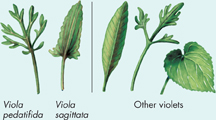Infer A road built through a forest splits a population of frogs into two large groups. The allele frequencies of the two groups are identical. Has genetic drift occurred? Why or why not?
Form a Hypothesis DDT is an insecticide that was first used in the 1940s to kill mosquitoes and stop the spread of malaria. As time passed, people began to notice that DDT became less effective. Explain, in genetic terms, how the insects became resistant to the pesticide.
17.3 The Process of Speciation
Understand Key Concepts
Temporal isolation occurs when two different populations
develop different mating behaviors.
become geographically separated.
reproduce at different times.
interbreed.
When two populations no longer interbreed, what is the result?
genetic equilibrium
reproductive isolation
stabilizing selection
artificial selection
Explain how the different species of Galápagos finches may have evolved.
Think Critically
Relate Cause and Effect Explain why reproductive isolation usually must occur before a population splits into two distinct species.
Form a Hypothesis A botanist identifies two distinct species of violets growing in a field, as shown in the left of the illustration below. Also in the field are several other types of violets that, although somewhat similar to the two known species, appear to be new species. Develop a hypothesis explaining how the new species may have originated.


solve the CHAPTER MYSTERY

EPIDEMIC
The genes of flu viruses mutate often, and different strains can swap genes if they infect the same host at the same time. These characteristics produce genetic diversity that enables the virus to evolve. Flu viruses also undergo natural selection. Think of our bodies as the environment for viruses. Our immune system attacks viruses by “recognizing” proteins on the surface of the viruses. Viruses whose proteins our bodies can recognize and destroy have low fitness. Viruses our bodies can't recognize have higher fitness. Viral evolution regularly produces slightly different surface proteins that our immune systems can't recognize right away. These strains evade the immune system long enough to make people sick. That's why you can catch the flu every winter, and why new flu vaccines must be made every year.

But now and then, influenza evolution produces radically new molecular “disguises” that our immune systems can't recognize at all. These can be deadly, like the 1918 strain. If a strain like that were to appear today, it could kill many people. That's why researchers are worried about “bird flu”—a strain of flu that can pass from birds, such as chickens, to humans.
Connect to the
 Explain why mutation and natural selection make developing new flu vaccines necessary every year.
Explain why mutation and natural selection make developing new flu vaccines necessary every year.Infer People do not need to receive a new measles vaccination every year. What does this suggest about a difference between flu viruses and the measles virus?
Apply Concepts Can you think of any other issues in public health that relate directly to evolutionary change?
Table of Contents
- Formulas and Equations
- Applying Formulas and Equations
- Mean, Median, and Mode
- Estimation
- Using Measurements in Calculations
- Effects of Measurement Errors
- Accuracy
- Precision
- Comparing Accuracy and Precision
- Significant Figures
- Calculating With Significant Figures
- Scientific Notation
- Calculating With Scientific Notation
- Dimensional Analysis
- Applying Dimensional Analysis




